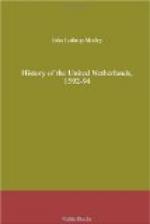Next day he permitted the garrison to depart; the officers and soldiers promising not to serve the King of Spain on the Netherland side of the Rhine for six months. They were to take their baggage, but to leave arms, flags, munitions, and provisions. Both Maurice and Lewis William were for insisting on sterner conditions, but the States’ deputies and members of the council who were present, as usual, in camp urged the building of the golden bridge. After all, a fortified city, the second in importance after Groningen of all those regions, was the real prize contended for. The garrison was meagre and much reduced during the siege. The fortifications, of masonry and earthwork combined, were nearly as strong as ever. Saint Barbara had done them but little damage, but the town itself was in a sorry plight. Churches and houses were nearly all shot to pieces, and the inhabitants had long been dwelling in the cellars. Two hundred of the garrison remained, severely wounded, in the town; three hundred and fifty had been killed, among others the young cousin of the Nassaus, Count Lewis van den Berg. The remainder of the royalists marched out, and were treated with courtesy by Maurice, who gave them an escort, permitting the soldiers to retain their side-arms, and furnishing horses to the governor.
In the besieging army five or six hundred had been killed and many wounded, but not in numbers bearing the same proportion to the slain as in modern battles.
The siege had lasted forty-four days. When it was over, and men came out from the town to examine at leisure the prince’s camp and his field of operations, they were astounded at the amount of labor performed in so short a time. The oldest campaigners confessed that they never before had understood what a siege really was, and they began to conceive a higher respect for the art of the engineer than they had ever done before. “Even those who were wont to rail at science and labour,” said one who was present in the camp of Maurice, “declared that the siege would have been a far more arduous undertaking had it not been for those two engineers, Joost Matthes of Alost, and Jacob Kemp of Gorcum. It is high time to take from soldiers the false notion that it is shameful to work with the spade; an error which was long prevalent among the Netherlanders, and still prevails among the French, to the great detriment of the king’s affairs, as may be seen in his sieges.”
Certainly the result of Henry’s recent campaign before Rouen had proved sufficiently how much better it would have been for him had there been some Dutch Joosts and Jacobs with their picks and shovels in his army at that critical period. They might perhaps have baffled Parma as they had done Verdugo.
Without letting the grass grow under his feet, Maurice now led his army from Steenwyck to Zwol and arrived on the 26th July before Coeworden.




